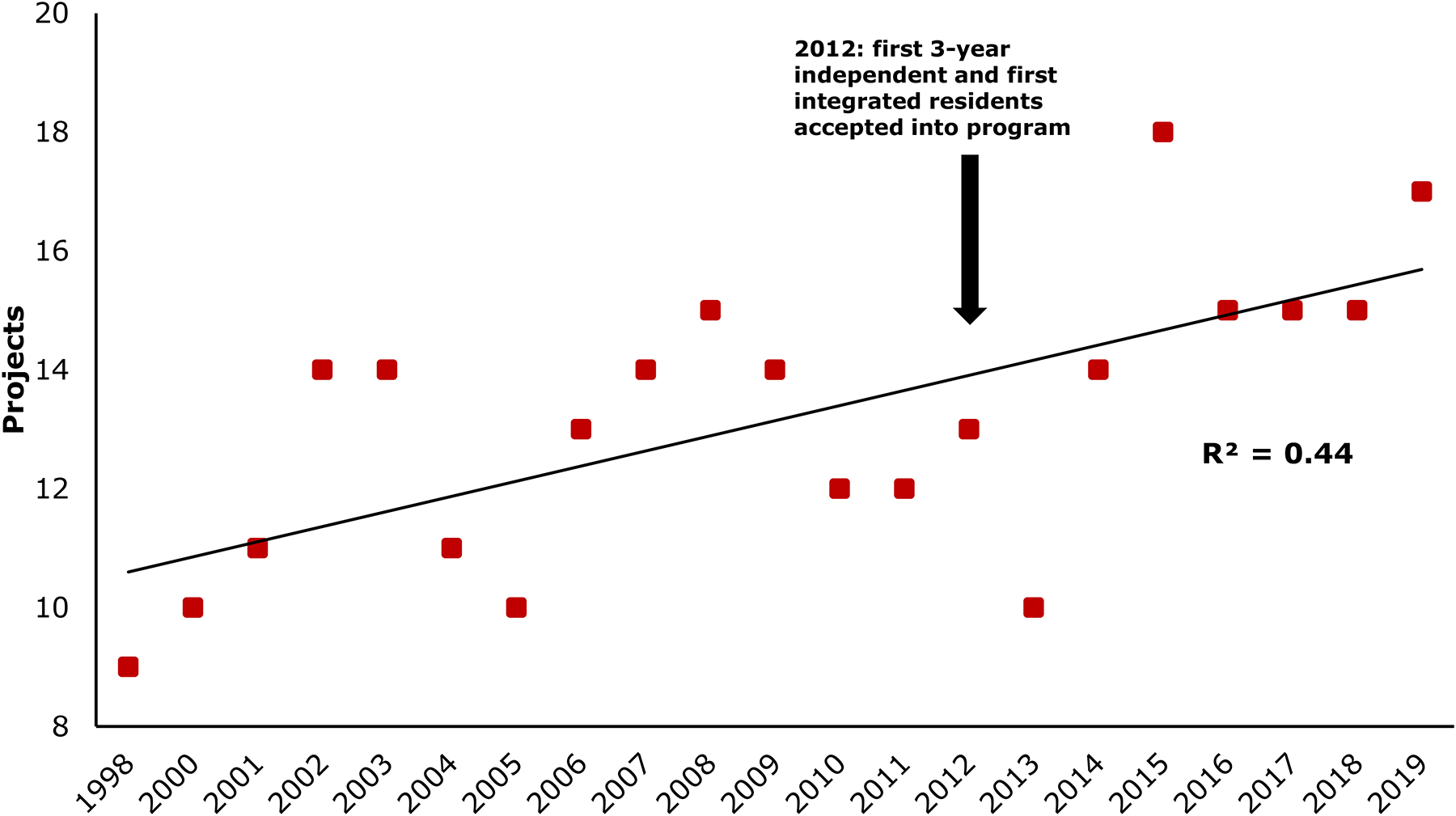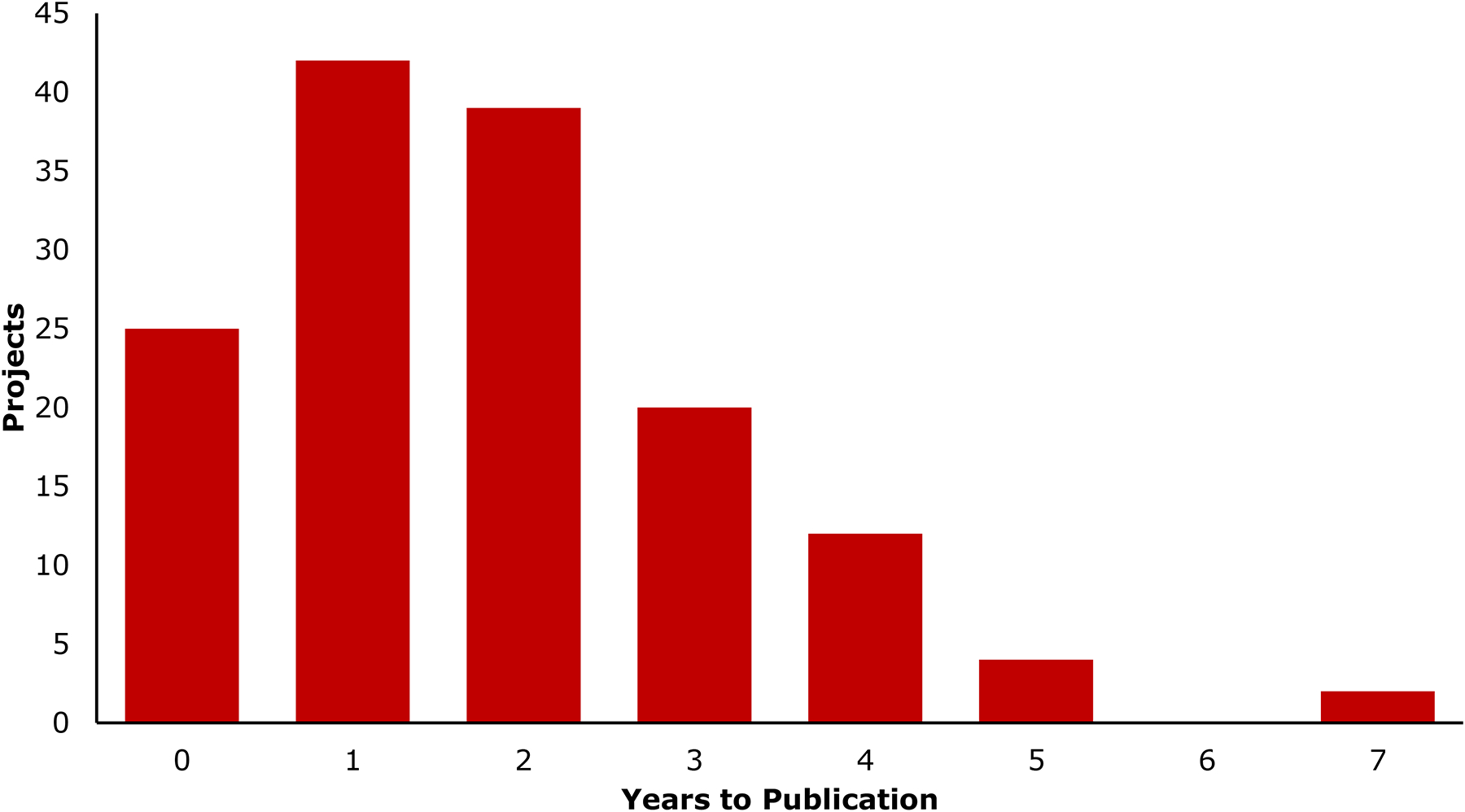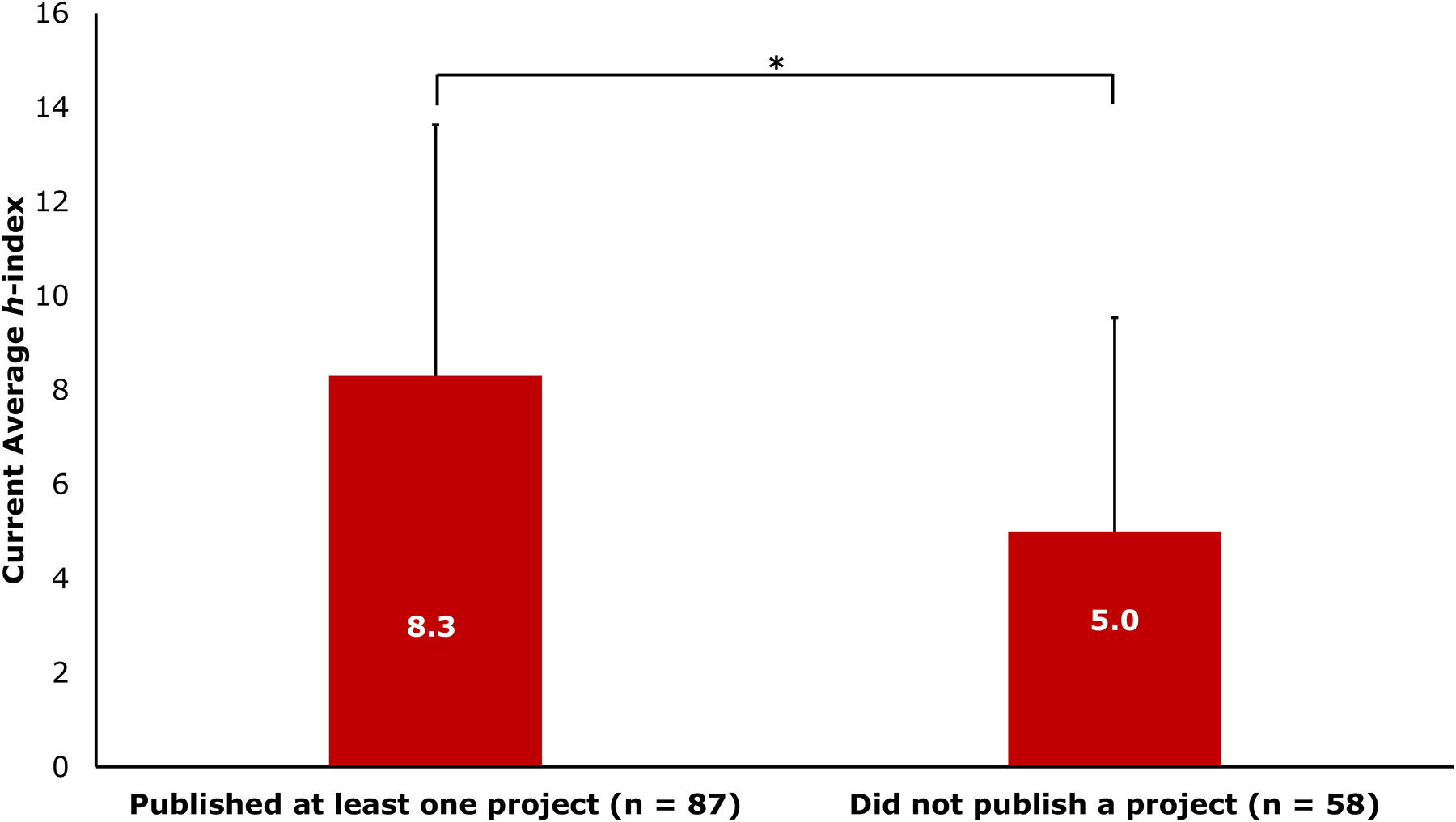Abstract
Background:
James Barrett Brown was one of the founders of Plastic and Reconstructive Surgery as a specialty in the United States. Susan Mackinnon started the James Barrett Brown Resident Research Day in 1997 in his honor to serve as an annual opportunity for trainees to present their research to the Division and a visiting contemporary leader in plastic surgery. We sought to determine the proportion of Resident Research Day projects that have progressed to publication.
Methods:
Available internal records from 1998–2019 were used to identify presenters and projects. Academic productivity of presenters was estimated with the h-index from the Scopus database.
Results:
One hundred forty-five students, residents, and fellows presented 276 projects at Resident Research Day from 1998–2019. These presentations were associated with 144 unique peer-reviewed publications, representing 52% of the presented projects. They were published an average of 1.8 years after presentation, and the presenter was the first or last author on 67% of them. The current average h-index of trainees who published at least one project (8.3) is significantly higher than the h-index of those who did not (5.0, p < 0.001).
Conclusions:
The James Barrett Brown Resident Research Day not only honors the legacy of Brown but also enhances scholarly activity of trainees. The opportunity to present and publish research teaches project planning, implementation, data analysis followed by manuscript preparation and the publication process. This important skill set can provide the foundation for the academic careers of future leaders in plastic surgery.
Keywords: Plastic Surgery Education, Plastic Surgery Residency, Plastic Surgery History, Peer-Reviewed Publication
Introduction
James Barrett Brown (Figure 1) is widely regarded as one of the most influential plastic surgeons of the 20th century1 and left indelible marks on the specialty as a researcher, clinician, teacher, and leader. He was a native Missourian, born and raised in Hannibal approximately 100 miles north of St. Louis along the Mississippi River. He attended college and medical school at Washington University in St. Louis and completed his surgical training at the affiliated Barnes and St. Louis Children’s Hospitals. He demonstrated his resourcefulness even as a surgical intern, using his own blood to coagulate the bleeding circumcision wound on a young boy with hemophilia2. He remained at Barnes Hospital/Washington University after residency as Vilray Blair’s junior partner. During Brown’s early career, he and Blair developed techniques to reliably harvest large skin grafts, borrowing the term “split-thickness” from Brown’s experience working in a leather shop in Hanibal3. He played a pivotal role in reconstructing the wounds of American casualties during World War II, serving as Chief of Plastic and Reconstructive surgery for the US Army and organizing plastic surgery centers both in England and in the United States for injured soldiers. While at Valley Forge, he oversaw more than 15,000 operations, during which there were no fatalities4. Following the war, he spent over a decade as Chief of Plastic Surgery at Washington University. His many and varied post-war activities included innovation in treatment of head and neck cancer and burns, including those exposed to radiation in the Manhattan project4. He revolutionized burn treatment by advocating for cleaning burns with tubbing rather than drying them with tannins. He wrote approximately 300 papers and eight books and was a founding member of the American Board of Plastic Surgery. He died in 1971 at Barnes Hospital, but his legacy has lived on most vividly in the over one hundred residents that he trained. The James Barrett Brown Prize was established in 1973 by the American Association of Plastic Surgeons to recognize the best plastic surgery paper published each year. Frank McDowell summarized his contributions, “Probably no man in history has had such an impact on the education of plastic surgeons, or on the specialty as a whole.”2
Figure 1.

James Barrett Brown served as chief of plastic surgery at Washington University from 1955–1968. Portrait of James Barrett Brown, circa 1950. Becker Medical Library, Washington University School of Medicine.
In 1997, the new Chief of Plastic Surgery at Washington University, Susan Mackinnon (Figure 2), established James Barrett Brown Resident Research Day in his honor. It began as a forum for plastic surgery trainees to present research performed with Washington University faculty mentors to an audience including a visiting leader in the field of plastic surgery. It has continued uninterrupted in this format to the present day. Fourteen of the visiting professors have served as Head, Chief, or Chair of Plastic Surgery at their institution. Since 1997, over one hundred trainees have presented at Resident Research Day. Oral presentations, however, only reach a small number of colleagues. Even before the time of James Barrett Brown, research of all types has been disseminated most effectively through publication in scientific journals. This process, now including peer review, is a foundational skill of the developing surgeon-scientist. In the present study, we hypothesize that Resident Research Day has encouraged high-quality research from trainees that is sufficient for publication. Additionally, we aim to evaluate the association between publication of Resident Research Day projects and academic productivity during trainees’ later careers.
Figure 2.

Susan Mackinnon served as chief of plastic surgery at Washington University from 1996–2020.
Methods
James Barrett Brown Resident Research Day presenters and projects were identified from available internal records from 1998–2019. Authors and projects were matched to published, peer-reviewed articles using the MEDLINE database in April 2020. Time to publication was calculated as a whole number by subtracting the Resident Research Day presentation year from the published journal issue year. To estimate academic productivity, the current h-index of all past Resident Research Day presenters was obtained from the Scopus database in April 2020. Effort was made to include all publications from authors who had published with different surnames over the course of their careers. All continuous variables were reported as mean ± 1 standard deviation. The h-index was treated as a continuous variable and evaluated with the Student’s unpaired t-test, with a two-tailed p-value <0.05 considered statistically significant.
Results
From 1998–2019, 145 different students, residents, and fellows presented a total of 276 projects at the James Barrett Brown Resident Research Day (mean 13.1 projects per year, Figure 3). The majority of trainees presented more than once over the course of their program. Presenters have included medical students, independent/combined/integrated residents, research fellows, and clinical fellows. There has been a trend toward increased total presentations per year as the number of trainees associated with Washington University has increased (correlation coefficient R2 = 0.44). After the program began accepting integrated residents starting in 2012, the total number of residents in the program increased from 9 to approximately 18 currently. Of the 145 presenters, 87 (60%) published at least one project (Figure 4). The 276 presentations are associated with a total of 144 unique peer-reviewed publications, representing 52% of the presented projects. The trainee who presented the project has been the lead author on 96 (67%) of the publications (Figure 5). The 144 journal articles were published a mean of 1.8 ± 1.4 years after presentation at Resident Research Day (Figure 6). The time to publication ranged from 0 (published same year) to 7 years. The 145 Resident Research Day presenters have an average h-index of 7.0 ± 5.3 (as of 4/2020), with a range of 0 to 28. The current average h-index for presenters who published at least one project is 8.3 ± 5.3, compared to the 5.0 ± 4.5 current average h-index for presenters who did not publish a project (p < 0.001, Figure 7).
Figure 3.

Total projects presented at James Barrett Brown Resident Research Day over time.
Figure 4.

Proportion of trainees who presented at Resident Research Day and published at least one of their projects.
Figure 5.

Proportion of published projects, including sub-group of presenters who served as lead author.
Figure 6.

Time to publication of Resident Research Day projects.
Figure 7.

Comparison of current average h-index between presenters who published at least one project and those that did not. Error bars represent one standard deviation (*p < 0.001).
Discussion
In a field driven by innovative solutions to problems with human form and function, the development and critical evaluation of new techniques through research is of paramount importance. James Barrett Brown personified this attitude through his entire career, and he serves as a role model to this day. Since its inception in 1997 by Susan Mackinnon, 145 James Barrett Brown Resident Research Day presenters have had the structured opportunity to conduct and present research in collaboration with a mentor. Exposure to this environment as a trainee prepares him or her for a career in academic surgery, as has been previously demonstrated. At the University of Wisconsin, the development of an integrated residency program with a structured focus on academic mentorship was associated with an increased proportion of graduates pursuing academic careers5. Additionally, a 2013 survey with 624 American Society of Plastic Surgery member respondents identified both greater numbers of publications during residency and stronger perceived mentorship as predictors of academic surgical careers6.
Several models exist to help residents integrate research into the demanding gauntlet of clinical training. Integrated plastic surgery residency programs currently allow up to 12 weeks of dedicated research time during 6 years of clinical training. This is often split into smaller blocks, making it difficult for trainees to work on longer-term basic science and translational research. Some programs provide residents with the opportunity (or requirement) for academic development time, where residents spend a year or more during their training conducting research and engaging in other academic pursuits. While providing more freedom for longitudinal experience with research, dedicated academic development time can create difficulty with funding and recruitment of residents7. During the era of the Resident Research Day at Washington University, residents have had the option, but not the requirement, to pursue a year or more of academic development time. Senior residents have been required to complete and present a project, regardless whether they interrupt their clinical training. Structured resident research opportunities have been implemented at other training programs. At the Johns Hopkins Department of Plastic Surgery, a review of 78 abstracts presented by residents from 2009–2013 demonstrated a 64% publication rate in peer-reviewed journals8. A logistic regression identified increased publication rate associated with both higher academic rank of the resident’s mentor and lower resident postgraduate year. Similarly, an evaluation of the University of Toronto Plastic Surgery Research Symposium encompassing nine years of available data from 2000–2013 showed that almost 40% of 130 abstracts presented by plastic surgery residents had been published in peer-reviewed journals9. They performed a focus group to evaluate qualitative factors in publication of research projects and identified project selection, formal training in research and statistics, collaboration between residents, and protected academic time as factors that positively impacted publication of projects.
In the 23 years since its inception, the James Barrett Brown Resident Research Day has allowed 145 trainees to present research early in their careers, and the majority of their 276 projects have been published in peer-reviewed journals. In doing so, this forum has enhanced the scholarly activity of trainees. Regardless of whether the project was eventually published, it has provided experience with project planning, implementation, and data analysis to its participants. Since most (about 80%) of the publications occurred within one to two years of presentation and about two-thirds featured the presenter as lead author, this format has allowed trainees the opportunity to take a leading role in manuscript preparation and publication while completing their program. Not all of the graduates from any program will pursue an academic career, but Resident Research Day has demonstrated the integral role of research in our specialty to all trainees at Washington University for over two decades.
There are several limitations to our current study. While the impact of work published in journals can vary widely, our study did not evaluate the quality of published projects beyond peer-reviewed acceptance. The study included Resident Research Day presentations through 2019, some of which have likely resulted in publications still in press or soon to be in press. Additionally, there were some instances of multiple presentations leading to a single publication, and this publication was only counted once. For both of these reasons, the actual rate of publication may be slightly higher than the reported 52%. The Scopus database is just one of several used to calculate an h-index, and it does not include all peer-reviewed publications. Any database can only provide a rough quantitative estimate of academic productivity, which is an inherently qualitative characteristic. Finally, as is the case in so many published clinical projects, the association between publications from Resident Research Day and future academic productivity does not necessarily demonstrate a causal relationship.
Washington University in St. Louis is the oldest plastic surgery residency program in North America, celebrating its 100-year anniversary in 2020. The evolution of plastic surgery as a specialty has been intertwined with this institution, and five of the ten most influential plastic surgeons of the 20th century (as voted by the American Association of Plastic Surgeons membership) have been associated with Washington University – Blair, Murray, Millard, Jurkiewicz, and James Barrett Brown1. As we move from the era of these founders into the next century of plastic surgery, the subjects of research have become both smaller and larger. Investigations into molecular mechanisms, supermicrosurgery, equity of access to care, patient safety and quality improvement, and patient-reported outcomes all owe a debt of gratitude to the paradigm of surgeon-scientist exemplified by Brown.
Conclusions
In the 1954 Presidential Address to the American Association of Plastic Surgeons, James Barrett Brown affirmed that as plastic surgeons, “we have a tremendous urge for improvement of our work and for the scientific data that will aid us in the care of patients.”10 The James Barrett Brown Resident Research Day, founded in 1997 by Susan Mackinnon, has honored his legacy by helping a new generation of plastic surgeons channel that urge into meaningful, published work.
Acknowledgments and Grant support:
Supported by the NIH National Institute of Neurological Disorders and Stroke Award K08NS096232 (to A.K.S.W.). The remaining authors have nothing to disclose.
Conflict of Interest Statement
The authors have nothing to disclose other than the grant funding acknowledged above.
References
- 1.Hallock GG. The plastic surgeon of the 20th century. Plast Reconstr Surg 2001;107(4);1014–4. [DOI] [PubMed] [Google Scholar]
- 2.McDowell F. James Barret Brown, M.D., 1899–1971. Plast Reconstr Surg 1971;48(1);101–4. [PubMed] [Google Scholar]
- 3.Blair VP, Brown JB. The use and uses of large split skin grafts of intermediate thickness. Plast Reconstr Surg 1968;42(1);65–75. [Google Scholar]
- 4.Cannon B, Randall P, Planas J, et al. James Barrett Brown. Ann Plast Surg. 1981;7(1);79–89. [DOI] [PubMed] [Google Scholar]
- 5.Mandel BA, Weber SM, Gutowski KA, et al. What influences a plastic surgery resident to pursue an academic career? Plast Reconstr Surg Glob Open 2018;6(10);e1860. [DOI] [PMC free article] [PubMed] [Google Scholar]
- 6.DeLong M, Hughes D, Tandon V, et al. Factors influencing fellowship selection, career trajectory, and academic productivity among plastic surgeons. Plast Reconstr Surg 2014;133(3);730–6. [DOI] [PubMed] [Google Scholar]
- 7.Ballard TNS, Sando IC, Kasten SJ, et al. Successfully integrating research into plastic surgery training programs. J Craniofac Surg 2015;26(8);2279–82. [DOI] [PubMed] [Google Scholar]
- 8.Susarla SM, Lopez J, Mundinger GS, et al. Abstract presentations by residents at an intramural research day: what factors affect publication? J Surg Educ 2015;72(4);566–71. [DOI] [PubMed] [Google Scholar]
- 9.Yumeen S, Ho ES, Wong K, et al. What factors influence resident research publication in the division of plastic surgery? J Surg Educ 2018;75(2);409–16. [DOI] [PubMed] [Google Scholar]
- 10.Brown JB. Presidential Address: American Association of Plastic Surgeons—1954. Plast Reconstr Surg 1954;14(2);157–9. [Google Scholar]


